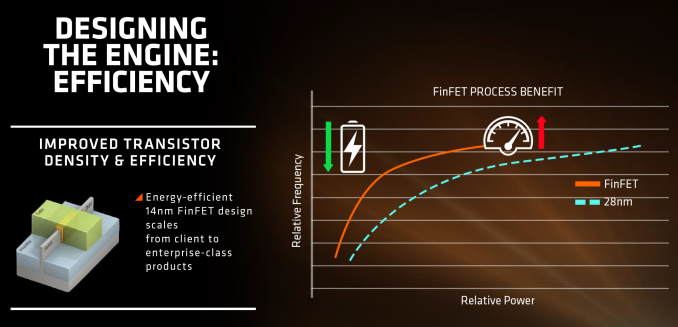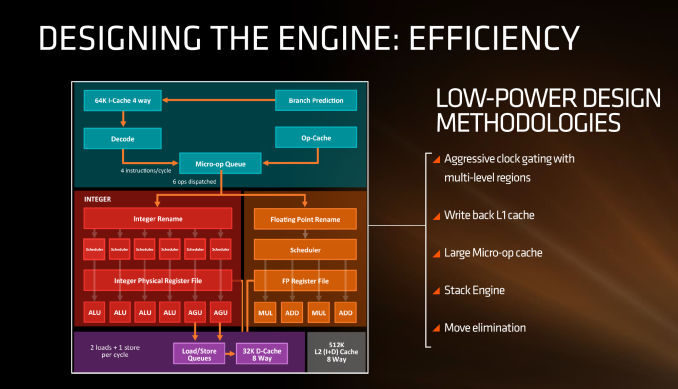AMD Zen Microarchitecture: Dual Schedulers, Micro-Op Cache and Memory Hierarchy Revealed
by Ian Cutress on August 18, 2016 9:00 AM ESTLow Power, FinFET and Clock Gating
When AMD launched Carrizo and Bristol Ridge for notebooks, one of the big stories was how AMD had implemented a number of techniques to improve power consumption and subsequently increase efficiency. A number of those lessons have come through with Zen, as well as a few new aspects in play due to the lithography.
First up is the FinFET effect. Regular readers of AnandTech and those that follow the industry will already be bored to death with FinFET, but the design allows for a lower power version of a transistor at a given frequency. Now of course everyone using FinFET can have a different implementation which gives specific power/performance characteristics, but Zen on the 14nm FinFET process at Global Foundries is already a known quantity with AMD’s Polaris GPUs which are built similarly. The combination of FinFET with the fact that AMD confirmed that they will be using the density-optimised version of 14nm FinFET (which will allow for smaller die sizes and more reasonable efficiency points) also contributes to a shift of either higher performance at the same power or the same performance at lower power.
AMD stated in the brief that power consumption and efficiency was constantly drilled into the engineers, and as explained in previous briefings, there ends up being a tradeoff between performance and efficiency about what can be done for a number of elements of the core (e.g. 1% performance might cost 2% efficiency). For Zen, the micro-op cache will save power by not having to go further out to get instruction data, improved prefetch and a couple of other features such as move elimination will also reduce the work, but AMD also states that cores will be aggressively clock gated to improve efficiency.
We saw with AMD’s 7th Gen APUs that power gating was also a target with that design, especially when remaining at the best efficiency point (given specific performance) is usually the best policy. The way the diagram above is laid out would seem to suggest that different parts of the core could independently be clock gated depending on use (e.g. decode vs FP ports), although we were not able to confirm if this is the case. It also relies on having very quick (1-2 cycle) clock gating implementations, and note that clock gating is different to power-gating, which is harder to implement.












216 Comments
View All Comments
m1ngky - Saturday, August 20, 2016 - link
It could be the performance boost is only 5% each generation because there wasn't a need for more due to the monopoly Intel has in the CPU market.Once decent competition from AMD emerges I'm betting we see more of a % boost then.
sonicmerlin - Saturday, August 20, 2016 - link
I seriously doubt it, Intel needs performance boosts to sell new products every year. If they could've then they would've.Byte - Thursday, August 18, 2016 - link
Value of top end K chips actually don't really go down that much. If you want to look for a Haswell devils canon, you still have to pony up around $300, maybe you can find a used one for $250ish, but same can be said for a Skylake. Even a 4770k or 3770k is hard to find for under $250 used. Even a 2770k i sold one not too long ago for $245.Nagorak - Thursday, August 18, 2016 - link
Prices for computer hardware isn't dropping very fast because performance has barely increased. A two year old CPU now is for all intents and purposes is just as good as a brand new one. There may be some marginal situations where the 5% difference in performance matters, but for the most part they perform identically.Compare this to the heyday of the late 90s when a two year old CPU might be half as fast as a new one. It was no surprise that upgrade cycles were shorter and resale values much less.
KPOM - Friday, August 19, 2016 - link
Tell that to all the people on MacRumors complaining that the 13" rMBP still has a Broadwell processor.Icehawk - Sunday, August 21, 2016 - link
While I agree with Nagorak, I have moved from a 2yr cycle to a 4+ cycle on CPU/platforms, I think the Apple folks have a right to gripe about the lack of updates - some of them are a few gens back at this point and prices haven't dropped enough to make up for that IMO.smilingcrow - Thursday, August 18, 2016 - link
Their whole CPU business is based on an Intel license to copy; ignoring the ARM stuff.blublub - Thursday, August 18, 2016 - link
1. Intel's X64 is based on AMD's license.....so what !? (remeber the Itanium disaster?)2. AMD also hold X86 licenses which are used by Inte - both x86 and x64 are cross-licenses
So in the end they both license/copy another -- so what!?
And I am pretty sure after the recent Intel/Nvidia rattle that the next Intel GPUs are being build via AMD's license
smilingcrow - Thursday, August 18, 2016 - link
There’s a massive difference though. AMD only has a license due to IBM insisting on Intel allowing a second manufacturer for its patented x86 CPUs.So AMD has been a parasite living on Intel patents with a degree of symbiosis in the relationship. That makes their various successful phases all the more noteworthy and hopefully Zen leads into another long awaited successful phase.
I think you are jumping to conclusions much to quickly over a mere PR spat with Nvidia.
ddriver - Thursday, August 18, 2016 - link
you are such an obvious intel troll fanboy that its just sad